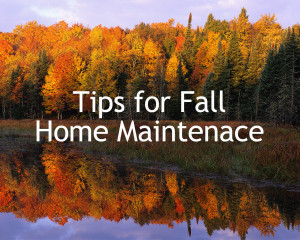 Well, it is mid Oct and it is time for fall home maintenance. Time to get ready in preparation for the winter, especially in northern climates. Inspect your home on a regular basis. Follow good maintenance practices is the best way to protect your investment in your home during the winter months. Consumers can save a lot of money and frustration by doing this home maintenance.
Well, it is mid Oct and it is time for fall home maintenance. Time to get ready in preparation for the winter, especially in northern climates. Inspect your home on a regular basis. Follow good maintenance practices is the best way to protect your investment in your home during the winter months. Consumers can save a lot of money and frustration by doing this home maintenance.
If you do not feel comfortable performing some of the home maintenance tasks listed below, or do not have the necessary equipment, for example, a ladder, you may want to consider hiring a qualified person to help you. There are many handyman service companies that abound in every city that will do this type of work. If you need general work done, a general handyman is ok and not too expensive. However, for furnace maintenance as an example, you are better off to hire professionals.
Fall Home Maintenance
Performing these checks and steps will not only save you money but will ensure that your home continues to look great. Perform any repairs to any areas that you notice during the performance of your checklist. Here is our list of items to consider on your checklist:
- Furnace or heating system serviced by a qualified service company every two years for a gas furnace, and every year for an oil furnace, or as recommended by the manufacturer.
- If you have central air conditioning, cover and protect the outside unit with a tarp or cover that comes with the unit. Turn the power off to the AC so there is no danger of the system running with this cover in place. The cover will protect your outdoor unit from damage from debris, ice, and snow.
- Lubricate circulating pump on a hot water heating system if you have one.
- Bleed air from hot-water radiators.
- Connect the power to the furnace and examine the forced air furnace fan belt, if installed, for wear, looseness, and noise. Clean fan blades of any dirt buildup.
- Check chimneys for obstructions, such as a bird or squirrel nest, before turning on your furnace.
Remove Dust
- Vacuum electric baseboard heaters to remove dust.
- Remove the grills on forced air systems and vacuum inside the ducts.
- Turn on gas furnace pilot light, set the thermostat to heat, and test the furnace for proper operation by raising the thermostat setting until the furnace starts to operate. Once you have confirmed proper operation, return the thermostat to the desired setting.
- Check and clean or replace furnace air filters each month during the heating season. Ventilation systems, such as heat recovery ventilators, filters should be checked every two months.
- Check to see that the ductwork leading to and from the heat recovery ventilator is in good shape, the joints are tightly sealed in any depth installation of plastic duct wrap is free of tears and holes.
- If the heat recovery ventilator has been shut off for the summer, clean the filters and the core, and pour water down the condensate drain to test.
Check Safety Items
- Check smoke, carbon monoxide, and security alarms, and replace batteries. Detectors should be replaced every seven years.
- Clean portable humidifier, if one is used, and install a new foam dispenser.
- Check to see that the bathroom exhaust fans and arrangements are operating properly. If possible, confirm that you are getting good airflow by observing the outside vent exterior damper which should be held open by the airflow.
- Check sump pump and line to ensure proper operation, and to ascertain that there no line obstructions or visible leaks.
- Replace window screens with storm windows.
- Remove interior insect screens from Windows to allow air from the heating system to keep condensation off window glass. It will allow more free solar energy into your home.
- Ensure windows and skylights close tightly; repair or replace weather-stripping as needed.
- Ensure all doors to the outside shut tightly, and check other doors for ease of use. Replace your weather-stripping if required.
- If there is a door between your house and garage, check the adjustment of the self-closing device to ensure it closes the door completely.
Keep Up with Outside Maintenance
- Ensure that the ground around your home slopes away from the foundation wall. Avoid water collecting against the wall and does not enter into your basement.
- Clean leaves from the eaves trough and roof and test downspouts to ensure proper drainage from the roof.
- Drain water from outdoor hoses. Clean interior valves to outdoor hose connection and drain the hose bib ( exterior Faucett), unless your house has frost-proof bibs.
- Have well water tested for quality? Test for bacteria every six months.
- If you have a septic tank, measure the slide and scum to determine if the tank needs to be emptied before the spring. Tanks should be pumped at least once every three years.
- Winterize landscaping, for example, store outdoor furniture, prepared gardens and if necessary protect young trees or bushes for winter.
If this list appears a bit daunting, schedule an activity every day. You will be surprised at how quickly it is finished. Comments are welcome concerning anything that we might have missed.
December 2nd, 2012 on 10:30 pm
I keep a list of maintenance things that I need to do in fall and spring. That way I do not forget anything